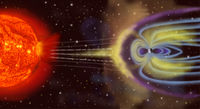
Photo from wikipedia
We investigate lower-hybrid drift waves (LHDW) in symmetric magnetic reconnection with zero guide field using three-dimensional particle-in-cell simulations. The long-wavelength mode with k ρ i ρ e ∼ 1 develops… Click to show full abstract
We investigate lower-hybrid drift waves (LHDW) in symmetric magnetic reconnection with zero guide field using three-dimensional particle-in-cell simulations. The long-wavelength mode with k ρ i ρ e ∼ 1 develops in the bifurcated electron current layer around the X-line within the width of the electron meandering motion from the mid-plane, where ρ i ( e ) is the ion (electron) gyroradius. The short-wavelength mode with k ρ e ∼ 1 develops in the separatrix region downstream of the electron outflow jet, producing electron vortices in the background flow frame. Electrons follow the E × B drift with corrections from the diamagnetic drift and are heated inside the vortices with diverging electric fields. In the vortices, ions have comparable E × B and inertia drifts, which together mostly cancel the diamagnetic drift. Toward the center of diverging field vortices, ions are decelerated, leading to a decrease in the perpendicular temperature, while the loss of low-energy ions results in an increase in the parallel temperature. Parallel electric fields exist as a combination of the LHDW wave field projected to the magnetic field direction and the penetration of whistler waves that are mainly outside of the LHDW layer. The magnetic flux tube is twisted in the vortices. The twist may potentially lead to slippage reconnection, as indicated by the non-uniform parallel potential variation across field lines, while the periodic variations of the twisting directions are a limiting factor.
Journal Title: Physics of Plasmas
Year Published: 2021
Link to full text (if available)
Share on Social Media: Sign Up to like & get
recommendations!